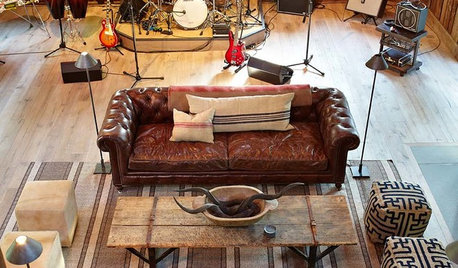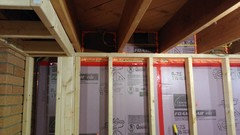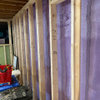XPS insulation and fire blocking advice needed.
dgeist
8 years ago
Featured Answer
Sort by:Oldest
Comments (9)
dgeist
8 years agolast modified: 8 years agoRelated Discussions
Basement Insulation With XPS
Comments (19)Does this seem a little extreme here in my zone 5/6 Ohio? My first floor has R19. It's over Code. But Building Science Corp.'s Dr. Lstiburek's rule of thumb is that for any home north of the Mason Dixon Line, follow the 10, 20, 40, 60 rule. That's R Value for, respectively, basement slab, basement walls, above grade walls and attic. If you're planning to stay for awhile and the labour is yours, there may be an economic payback. The space will definitely be more comfortable. My biggest fear is trapping water with too much insulation. At Roxul sales displays, they like to run a water fountain through a chunk of their product. The water runs right through and is not absorbed. will my basement still be the coolest part of my house in the summer? Well, mine have been. But that's probably because of the leakage of HVAC-cooled air into the basement, where the cooling equipment is also located. Is it ok to just add fiberglass insulation without a vapor barrier, and close up with sheetrock? Unless you're in an extreme cold climate such as northern Alaska, leave the poly vapour barrier out. All you need is painted drywall as a vapour retarder. in the rim joist, I have 1" of closed cell foam covering the entire rim joist. Should I add XPS boards and seal, or just add unfaced fiberglass there as well? Either one works. See illustration below from Building Science Corp. Info. Sheet 511, p. 2....See MoreXPS and fire blocking
Comments (15)Very nice pdf picture. If adding that vertical strip of drywall to the insde of a 2 X 4 every 10 or so feet really can make a difference, what the hell, it easy enough to do. Now real way to do that with a continuous run of XPS though. Now, the horizonatl stuff looks like you essentially need to cut a stip of drywall large enough to cover the 2 X 4 + the depth of your XPS and add between to the top. I assume, technically, the areas I am not framing but rather attaching drywall right to the XPS really should be capped with a skinny strip as well...I'd need to think of how to attach it and if it really would be worth it....I guess it depends of how level I cut XPS....or I might even have enough room to lay a 2 X 4 over the xps and rest the other half on the concrete, maybe some more foamseal underneath...not sure how I'd attach it....sounds like there is little bang for the buck if there is a fire though!...See MoreInsulation a thin wall (block)
Comments (14)no. put the 1st layer xps between furring strips already there. then put another 2nd layer that will cover both the layer of xps against the block & furring strips. when installing drywall use longer screws and screw thru drywall, top layer of xps & into furring strips. then you'll have the layer against the wall installed inbetween strips, and another layer of 3/4" xps on top. this will give you as much as in basement. not suprised you didn't find R-value. tj..for my radiant barrier in the attic..where the work in hot climates, I paid .05 per sq ft. single sided fsk radiant barrier. this is my material of choice. not much sense in paying more for a more expensive product that works just the same as single sided product. what sells the more expensive product is hype. I'm very pleased with radiant barrier in attic in my hot climate. reflects the heat nicely the actual insulation on the floor of the attic is what keeps attic temps in the attic. not the radiant barrier. the radiant barrier has minimal R-value. its value is in emissivity. even with 4'x8' sheets of iso board ( R-7 foam with foil facing) I can cut with no waste. tape measure, tsquare razor knife. no problem. oh and I get actual R-VALUE. Double-bubble stacked x3 with 1/2" air gap = r50. This is FACT. no its sales hype. if you find R-value of foil bubble foil wrap..please post it. just not from mfg selling the product, a site where the info is unbiased. I'm not the only person to know this is true. those scam artists come out every year taking advantage of older people with RB rolled over insulation in attics. scam. scam. scam. http://www.energyvanguard.com/blog-building-science-HERS-BPI/bid/29497/The-Foil-Faced-Bubble-Wrap-Sham-Understanding-Radiant-Barriers read the comments Kvalue folks strike again! LOL!...See MoreInsulate Utility/Electrical Room with XPS or switch to ISO??
Comments (1)The issue in your case is not so much supporting fire as it is contributing toxic smoke. That can be delayed by a "thermal barrier" (usually 1/2" non-fire-resistance-rated gypsum board.) Polyisocyanurate foam board does not need a thermal barrier when exposed inside a house but it has an aluminum foil facing on both sides so it will create a vapor barrier if applied directly to the interior face of a foundation wall which will prevent the wall from drying to the inside. Extruded polystyrene foam board is vapor semi-permeable (.8 perms) and expanded polystyrene foam board is vapor permeable (4 perms). Both must have a 1/2" gypsum thermal barrier over it which it appears you will be installing anyway so no additional protection is required. For additional protection in a furnace room, you could use 5/8" fire-resistance rated gypsum board (often called type X) or just two layers of ordinary gypsum board. When the board is not in a free-standing fire partition, the fire-resistance rating doesn't add any real protection....See Moreworthy
8 years agolast modified: 8 years agodgeist
8 years agoworthy
8 years agodgeist
8 years agoworthy
8 years agolast modified: 8 years agoMatthew
8 years agodgeist
8 years ago
Related Stories

REMODELING GUIDESCool Your House (and Costs) With the Right Insulation
Insulation offers one of the best paybacks on your investment in your house. Here are some types to discuss with your contractor
Full Story
WINDOW TREATMENTSEasy Green: 9 Low-Cost Ways to Insulate Windows and Doors
Block drafts to boost both warmth and energy savings with these inexpensive but effective insulating strategies
Full Story
REMODELING GUIDESContractor Tips: Advice for Laundry Room Design
Thinking ahead when installing or moving a washer and dryer can prevent frustration and damage down the road
Full Story
MATERIALSInsulation Basics: What to Know About Spray Foam
Learn what exactly spray foam is, the pros and cons of using it and why you shouldn’t mess around with installation
Full Story
GREEN BUILDINGInsulation Basics: Heat, R-Value and the Building Envelope
Learn how heat moves through a home and the materials that can stop it, to make sure your insulation is as effective as you think
Full Story
GREEN BUILDINGInsulation Basics: Natural and Recycled Materials
Consider sheep’s wool, denim, cork, cellulose and more for an ecofriendly insulation choice
Full Story
GREEN BUILDINGEcofriendly Cool: Insulate With Wool, Cork, Old Denim and More
Learn about the pros and cons of healthier alternatives to fiberglass and foam, and when to consider an insulation switch
Full Story
KNOW YOUR HOUSEKnow Your House: The Basics of Insulated Concrete Form Construction
Get peace and quiet inside and energy efficiency all around with this heavy-duty alternative to wood-frame construction
Full Story
DECORATING GUIDES10 Design Tips Learned From the Worst Advice Ever
If these Houzzers’ tales don’t bolster the courage of your design convictions, nothing will
Full Story
THE ART OF ARCHITECTURESound Advice for Designing a Home Music Studio
How to unleash your inner guitar hero without antagonizing the neighbors
Full Story






worthy